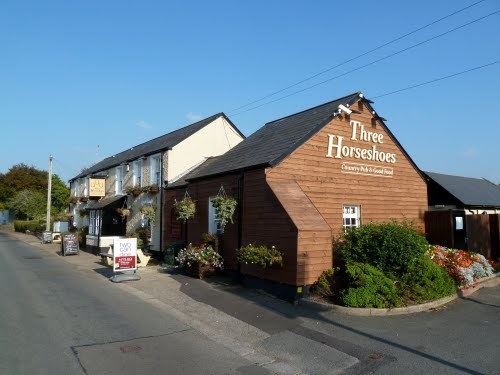Local time Tuesday 5:56 AM | ||
 | ||
Weather 7°C, Wind NE at 13 km/h, 92% Humidity | ||
Peterston-super-Ely (Welsh: Llanbedr-y-fro) is a village and community in the Welsh county borough of the Vale of Glamorgan on the River Ely.The community population taken at the 2011 census was 874.
Contents
- Map of Peterston super Ely Cardiff UK
- History and description
- Amenities
- Governance
- Famous residents
- References
Map of Peterston-super-Ely, Cardiff, UK
History and description
As its name suggests, the village lies on the River Ely, on the other side of which is the Coryton estate. The local parish church (in heavily restored simple Perpendicular style) is dedicated to Saint Peter. There are small remains of a castle.
The oldest structure in the conservation area is the remains of Peterston Castle situated beside Castle Bungalow. The castle was built by the Norman lords of the manor, Le Sor family probably in the mid 13th century. It replaced an earlier structure destroyed by the Welsh and in turn was sacked and destroyed by Owain Glyndwr in 1403. The earliest feature of St. Peter’s Church is the 14th century chancel arch but the church is more notable for its Perpendicular style tower. The west tower with its corbelled battlements and gargoyles is 15th century. The chancel was mostly rebuilt in 1890-91 by Kempson & Fowler. From the medieval period until the 19th century, the settlement was a small rural community with the majority of its inhabitants deriving an income from agriculture. Major change arrived with the construction of the railway (opened 1850) and the opening of a railway station west of the village in the second half of the 19th century. A comparison of the pre-railway Tithe Map of c. 1840 with the First Edition Ordnance Survey of c.1880 shows that the railway required a slight re-alignment of the through road giving rise to the unusual alignment of properties south of the railway bridge. During the immediate post-railway period a school was built south of the church, The Old Rectory was built in 1857 and the chancel of St. Peter’s Church was largely reconstructed. It has been suggested that the higher roots of the older yews in the churchyard indicate that the churchyard was cleared in the 19th century. In the early 20th century John and Reginald Cory, coal magnates, began a Garden Village to the south of, and quite separate from, the historic village, now known as Wyndham Park. Main Avenue was, and remains, a wide and straight spine road uphill from a bridge over the river. The road originally crossed the river on the site of today’s footbridge but is now re-directed westwards along Wyndham Park Way. The church’s lych gate is dedicated to those who fell in the Great War. The cost of the playing fields was deferred by grateful parishioners following the 1939-1945 War. Further housing development took place in the late 20th century adding to the settlement’s population and thereby helping the village to continue to support a village shop and school.
Peterston-super-Ely is the primary outdoor filming location for the Welsh-language soap opera, Pobol y Cwm.
Peterston Church in Wales Primary School presently has around 180 pupils.
Amenities
Entering the village from the east (Cardiff) side one will pass the local village primary school on the right hand side and the first of two pubs, The Three Horse Shoes on the right hand side. The three Horse Shoes is a Brains Pub and is currently run by Digby and Jenny Rees.
Past the Pub lies the local village shop and post office, the local BT telephone exchange followed by the church of St Peters.
The church of St Peters was used as an outdoor and indoor filming location in the third series of in the filming of wedding scenes in the third season of Gavin & Stacey. In the episodes, local residents were used extensively as extras throughout the series. Opposite the Church lies the memorial park, which was created as a memorial to the brave soldiers who died in World War I. Next to the playing fields is the village hall, which was left to the villagers for the continuation of community spirit. The local playing fields are the home base of the Peterston Juniors Football Club and the local tennis club. The tennis club contains three modern all weather asphalt courts and youth community coaching is available. A community playground was erected in 1975 and was only recently upgraded to modern standards in 2013 by local residents through fundraising.
Past the memorial fields is a railway bridge crossing section of the South Wales Main Line from Swansea to Cardiff Central, and onwards to London Paddington. A local train station existed close to Station Terrace until 1971 when it was demolished. Local campaigns have been carried out to rebuild and reopen the station. As you travel over the bridge, the second of the village pubs, The Sportsmans Rest lies on the right hand side, a freehold pub with play area at the rear.
Peterston-Super-Ely is part of the Vale of Glamorgan Council and the local MP is Alun Cairns. The local county councillor is Rhodri Traherne.
Governance
An electoral ward in the same name exists. This ward stretches north from Peterston. The total population of the ward taken at the 2011 census was 2,289.
